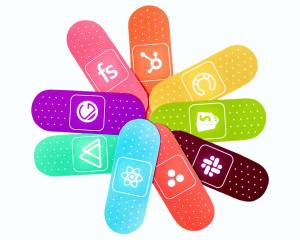When it comes to mobile app development, as a business owner, you probably have a fair insight into the kind of app you wish to build. You might have outlined your targeted markets, customer needs, and the expected ROI. But most businesses still depend on app development services to assist them through the development phase.
State of Mobile App Technology Stack
Building a mobile app is no easy feat. A lack of technical know-how might severely affect your app development process. Choosing the right app stack will help you cut down costs, increase scalability, and speed up the process. You should carefully vet and select the appropriate app stacks to avoid losses.
You will have to brief your developing partners on the design and features of your app.
You also need to have a vision for the strategic implementation of the design. While colluding with your development partners, you need to have a basic knowledge of app stacks. Hence it is imperative for business houses to understand the basics of mobile app stacks.
While deciding on the mobile app stack, pay special attention to these four criteria:
- The type of app you wish to build – Do you want a native app or a hybrid app? Is it a gaming app or a basic information app? The app stacks you use will be largely determined by the type and complexity of the app.
- The time-to-market estimate – Timing plays a crucial role in gaining a competitive advantage. If you wish to first in the market, you might have to consider using React Native or Xamarin app development.
- Your total budget – If you are a startup or small business with limited funds, you might consider building an MVP app first. On the other hand, large businesses often prefer native apps that can be developed on both Android and iOS simultaneously.
- Future Strategy – Scalability, maintenance, and upgrading of your apps should be the main focus while planning for the long-term viability of your app. Each extra element will directly affect the technological stacks you need to use for your app.
What is App Stack?
A mobile app stack is a blend of technological tools that helps create a mobile application. Typically, we would use a combination of programming language, software and frameworks to build an app.
App developers stack these aspects on top of one another to create the final product.
A typical mobile app technology stack will consist of four elements.
- Frontend Development – Frontend is also known as the client-side of the development process. It refers to the user interface of an app that directly interacts with customers. It relates to the visual experience of the app. Usually, it will include iOS or Android applications written in Java or Objective-C/SWIFT.
- Backend Development – Backend is also known as the server-side of the app development process. The intelligence of a mobile app is tied to the robustness of its backend process. It provides capabilities such as user management, push notification, app management, insights, secure backend integration, etc.
- Development Platform – It is important to understand which developing platforms best integrate the user-interface with backend libraries. These are additional methods to design and develop the app.
- Additional Tools – This includes extra features and functionalities that you would like to integrate – like security, CDN (Content Delivery Network), and network dependency. Depending on the app type, you need to define your prerequisites to analyze which features will work best.
Types of Mobile App Technology Stack
Native App Stack
Native apps are oriented entirely towards the platform they are built on. This makes them faster, more reliant, and compatible only with their specific OS. Native apps do not require third-party API integration. There are two types of platforms for Native apps – android and iOS.
Because of their robust features and excellent performance, they are heavily preferred by all kinds of businesses. However, they are slightly more expensive to build, as apps need to be developed for both platforms.
Android App Stack
Android platforms have a larger user base than iOS. If you wish to build an app on this platform, you need to consider the following:
Programming Language
The most commonly used programming language for Android apps are Java and Kotlin. Java is an open-source programming language that is quite popular with developers. It used to be the primary language to develop android apps. It is highly secured with multi-threaded capabilities. It comes with a wide range of features that makes it extremely scalable to build even the most complex apps.
Kotlin is the first official language of Android development and has gained wide popularity since its advent in 2016. Developers can use Kotlin interchangeably with Java.
They can switch languages anytime during the development phase, thus saving time on code compilation. Kotlin provides a wider variety of syntax and coding than Java, which means developers need to write fewer code lines.
Toolkit
The preferred toolkit for android apps is the Android Studio. The platform is integrated with code editing, debugging, and performance tools. It provides a flexible framework and an instant build/deploy system for app development.
SDK
The Android SDK is a set of developer tools and libraries necessary to build android apps. Each version of Android comes with its own set of SDK that needs to be installed by the developer.
iOS App Stack
According to Buildfire, the Apple App store has over 1.96 million apps to download. Since its redesign, the App Store sees over 500 million weekly visitors globally. If you wish to develop your app on this platform, consider the following:
Programming Language
There are two languages that you can use to build an iOS app – Objective C and Swift. Objective C has been the primary coding language for many years, but these days, it is mainly used to support legacy apps. Objective C offers great compatibility with C++ and a dynamic runtime environment.
Swift is comparatively a new programming language that has gained wide recognition among developers. It offers more functionalities and less error-prone coding syntax. It also allows apps to be built lighter and faster hence enhancing the overall efficiency.
Toolkit
Xcode is the preferred tool kit to develop iOS apps. It is a development framework that comes with integrated support for Git repositories. It also has a graphical editor, debugging tools, and documentation tools.
SDK
The iOS SDK comes with an API that seamlessly integrates between platforms and applications. It also offers customized tools for Apple’s touchscreen interface.
Hybrid App Stack
Hybrid apps are not device-dependent, which means they can be used in both android and iOS platforms. They are developed using a shared code in a native shell, making them look and act like a native app. Since you need to develop a single app across all platforms, hybrid apps are much cheaper to develop than Native apps.
There are two different frameworks available to build hybrid apps.
Apache Cordova
Apache Cordova is an open-source platform that provides a framework to build apps using HTML, CSS, and Javascript. It comes with a set of pre-developed plugins that provide access to the camera, GPS, file system, etc.
Iconic
Iconic is an open-source, Angular-based mobile UI development framework with rich functionalities. It uses HTML, CSS, and Javascript to develop hybrid apps compatible across devices. It comes prebuilt with plugins that help integrate device-specific features, like GPS, camera, etc.
Cross-platform App Stack
The only common feature between Hybrid and Cross-platform apps is their code shareability. Cross-platform apps use a native rendering engine, enabling you to develop apps that look and feel native. But there is a downside to it. Cross-platform apps build bridges to reach native modules, which is why there can be performance lags. Also, sometimes, customization can be an issue.
There are two frameworks on which you can build a cross-platform app.
React Native
It is an open-source app development environment created by Facebook and launched in 2015. The elements wrap existing native code while interacting with native APIs. It comes with a core set of platform-agnostic components and can be written on Javascript or Typescript.
Xamarin
Xamarin is an open-source platform created by Microsoft that allows app developers to share up to 96% of their code. It uses C# and .Net as its main language and is considered a major player in the app development market.
Select the Right Mobile App Technology Stack
Now that you know what is app stack, choosing the right combination of tools will be much easier. However, remember that languages and tools evolve or degenerate over a period of time. With each new technological jump, you may need to update or swap older tools and programs.
Selecting the optimal mobile app technology stack can be a challenging issue. Before you opt for app development services or choose a web app technology stack, do a complete groundwork on your requirements. Build your decisions on well-researched ideas and business viability.
Image Credit: anthony shkraba; pexels; thank you!











